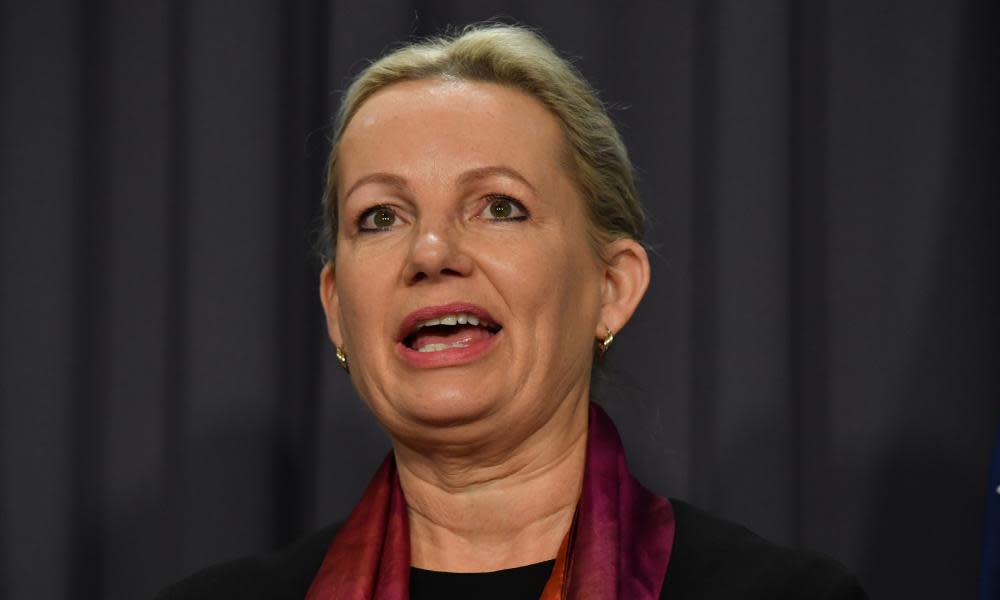Environment minister rules huge renewable energy hub in WA ‘clearly unacceptable’

A massive renewable energy export development in the Pilbara has been declared “clearly unacceptable” by the federal environment minister due to its impact on threatened migratory species and internationally recognised wetlands.
Sussan Ley’s ruling means the proponents of the $50bn Asian renewable energy hub will need to significantly revamp their plans if the development is to go ahead. They argue it could revolutionise the production of hydrogen globally by showing it can be created at an affordable price using solar and windpower.
The proposed hub would be built across about 666,030 hectares east of Port Hedland in northern Western Australia, an area about half the size of greater Sydney. The development, which proponents have called the world’s largest renewable energy project, would require about 20,000 hectares to be cleared.
A 26 gigawatt-capacity hybrid solar-windfarm would be used to power 14GW of electrolysers that convert desalinated seawater into green hydrogen. Most of the hydrogen would be converted to green ammonia for safe export. The project includes processing plants, marine infrastructure including pipelines and an offshore export platform, and a new town to house workers.
It was granted major project status by the federal government last year, a step designed to smooth the approval process, and the WA government has green-lit the first stage of the development.
Related: Green giants: the massive projects that could make Australia a clean energy superpower
But Ley decided an updated proposal submitted to the federal environment department last month would have clearly unacceptable impacts on matters of national environmental significance set out under the Environment Protection and Biodiversity Conservation [EPBC] Act.
Through a spokesperson, the minister said the project would affect the ecological character of a Ramsar-listed Eighty-mile beach site and several migratory species, including seven threatened species and an internationally significant waterbird population.
“The minister found the marine component of the infrastructure corridor would disrupt tidal movements and processes and this would seriously impact the habitats and life-cycle of the native species dependent upon the wetland and, accordingly, the ecological character of the Eighty-mile Beach Ramsar site itself,” Ley’s spokesperson said.
The consortium behind the hub said it was working to understand the minister’s concerns and would engage with her and the environment department as it continued to develop the project design. It said the project was a “significant economic and clean energy opportunity for Australia”.
The industry group the Clean Energy Council raised concern about the decision, saying it understood the project had been rejected before the completion of detailed environmental studies.
Related: Liberal-led committee says Angus Taylor’s planned change to renewable energy agency could be illegal
It said the hub was a “transformative economic opportunity” for Australia and it was “seeking urgent clarification” from Ley “to address the perception that this decision is inconsistent with well-established processes or with the treatment of non-renewable projects”.
“We expect that the Commonwealth will work in partnership with the Asian Renewable Energy Hub to provide the necessary guidance to appropriately assess and address any environmental impacts,” the council said.
The Pilbara hub was initially planned as a means to sell green energy to coal-rich Indonesia via sub-sea cable but that idea has been dropped in favour of hydrogen, based on the expectation that by 2035 the world will need vast amounts of green fuel to replace coal, gas and oil.
Alex Hewitt, the founder and director of CWP Renewables, an Australian-based partner in the hub, last year told Guardian Australia the development was the country’s first “renewable energy project at oil and gas scale”.
Hewitt said the scale of the project would allow hydrogen to be produced for less than $2 a kilogram, the “stretch goal” identified by the Morrison government as the point at which the fuel is expected to be cheaper than fossil fuel alternatives.
The consortium is aiming to make its first shipment of green energy to Asia in 2027. The plan is to ship it as green ammonia, which is created by blending hydrogen with nitrogen and is safer to transport.

 Yahoo Movies
Yahoo Movies 
